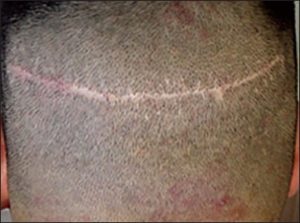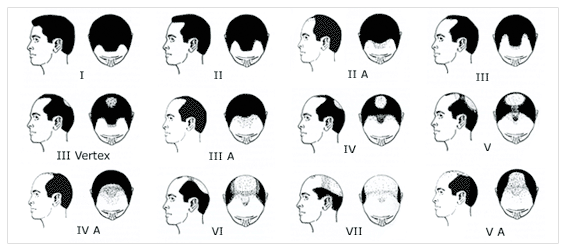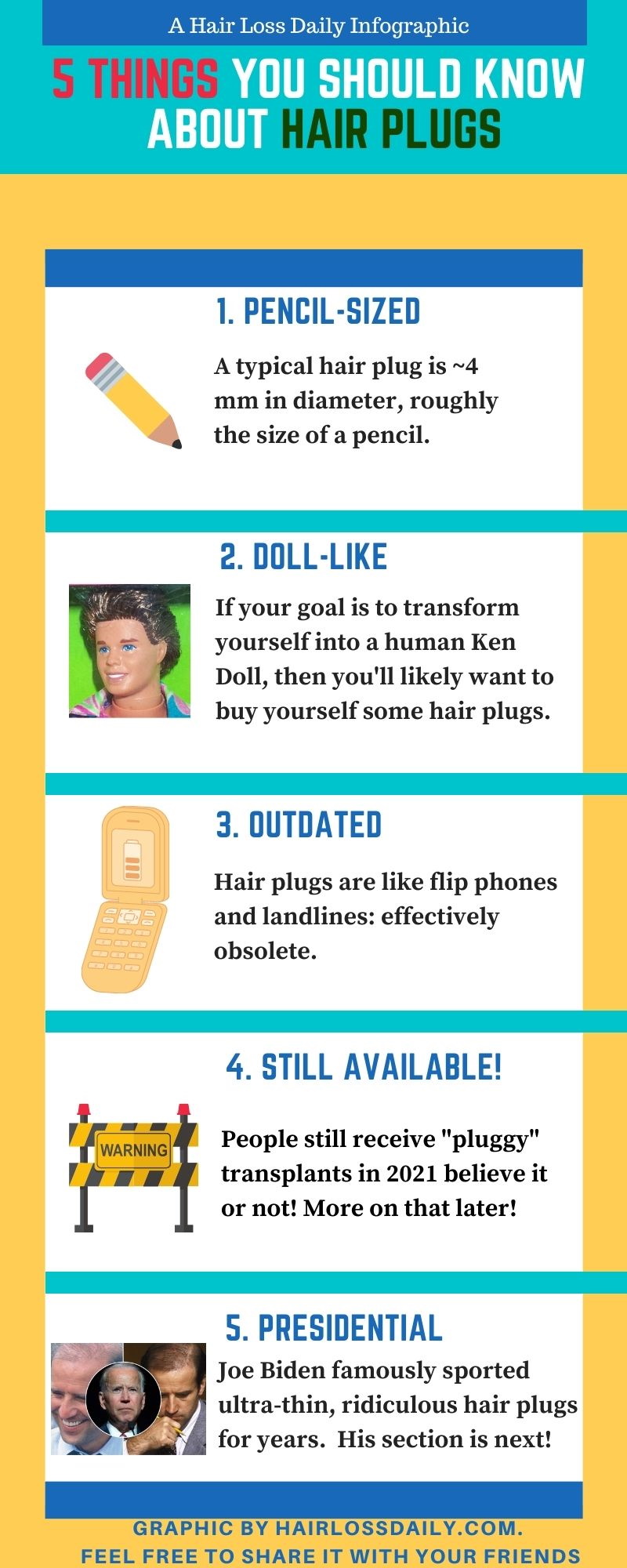Last Updated on August 16, 2023 by Robert Price
Hair plugs — like hair metal, The Cosby Show, and Madonna — were popular and fashionable in the 1980s. Today, not so much.
For over three decades, hair plugs have effectively been obsolete.
They always looked ridiculous and unnatural.
But for a brief and baffling moment in time, back when Bill Cosby was still America’s dad and horrible hair bands ruled the airwaves, many people preferred hair plugs to the alternative: baldness.
Now, I realize “hair transplant” and “hair plugs” are two terms that are sometimes used interchangeably, even by experts in the field.
So, in this post, I’ll explain the difference between hair plugs and hair transplantation once and for all.
This article will also cover:
- The strange and fascinating history of hair plugs.
- How the procedure gained popularity even though it yielded less than desirable results.
- Famous celebrities who sported hair plugs. Spoiler alert: one of them is the President of the United States.
- Hair plug repairs, modern alternatives to the procedure, and much more.
I’ll try to keep this post as concise, fun, and skim-friendly as I possibly can. Starting with the basics, here’s everything you need to know about hair plugs.
First off, What Are Hair Plugs?
I’m a hair loss blogger and researcher with thousands of hours of experience in the field. So when I think of hair plugs, I think of this…

Ken Doll (brunette version). This is Barbie’s boyfriend with his pluggy hairstyle.
When I think of hair plugs, I picture Barbie’s famous boyfriend, Ken, with his unnatural and doll-like hairline. I think of an outdated procedure that no longer has a place in 2023.
Hair Plugs – The Basic Definition.
Basically, hair plugs are just round groups of hairs used for transplant procedures. They’re typically collected from a “donor” area on the back and/or sides of the head.

I sometimes call the donor area the “Dr. Phil zone.” It’s the area on the sides and back of the scalp where even the baldest of men tend to have hair. Some (not all) hairs from this zone can typically be harvested for transplants.
The size of a hair plug is what differentiates it from the grafts used in modern hair transplants.
Believe it or not, traditional hair plugs were about four millimeters in diameter.
That’s roughly the size of a pencil!
Each plug contained up to 8 hairs.
More Plugs, More Problems
Human hair is composed of follicular units.
Each unit contains 1-3 hairs.
So, obviously, the fact that hair plugs contained up to 8 hairs was a big problem!
Also, the center hairs in these plugs would often get squeezed by the surrounding hairs and fall out, creating a donut-like appearance. Not surprisingly, a bad hair-plug job can easily be seen from across a room!
Now, you may be asking yourself this question.
How Did Hair Plugs Ever Become Popular?
A valid question.
Traditional hair plugs look ridiculous and unnatural.
The reason they were popular in the 70s and 80s (and even into the 90s) is fairly simple. Some people preferred the “pluggy” look vs. the alternative: having no hair at all.
As far as hair restoration options went, hair plugs were it. And this was before the shaved look became fashionable, thanks to celebrities like Michael Jordan and Bruce Willis, two members of my bald hall of fame.
There were few if any treatments available too, at least not until 1988 when Rogaine was introduced and became the first effective OTC remedy for hair loss.
If you wanted to fix your receding or balding hair, you either had to get hair plugs or wear a toupee. And toupees of course are more stigmatized than hair plugs.
Now, in case you haven’t been paying close attention so far, here’s an infographic that may be useful to you.
Celebrities Who Have Sported Hair Plugs
A number of prominent celebrities and public figures are known for having hair plugs, including:
Roger Stone
Roger Stone, the notoriously sleazy yet effective political operative recently pardoned by president Trump, sported hair plugs for many years. Notice the super thick, doll-like hairs along the hairline. I believe he had his procedure repaired since this photo was taken and now his hairline looks more natural.
Joe Biden

President-elect Biden, rocking his “squeezed” hair plugs as confidently as a person can rock squeezed out hair plugs…
Fun fact: In the late 70s, my dad drove President Biden to an event when he was a student at a California law school. Biden was already in congress at that point, and already well on his way to being bald.
He eventually had his hairline fixed to some degree, though whether or not those sparse and unnatural-looking plugs enhanced or diminished his appearance is debatable.
Since sometime in the early 2000s perhaps, prior to becoming the vice president to Barack Obama, Biden has sported a relatively natural-looking and age-appropriate hairline. In other words, he had his hair plugs repaired. You can see the results of that repair below…

His current hairline is far from perfect and shows some thinning and recession, but it’s age appropriate, looks reasonably normal, and helps frame his face.
Modern Alternatives to Hair Plugs (FUT and FUE)
The main difference between old-school hair plugs and the grafts used in modern procedures is the size. Grafts are extracted via two techniques — FUT and FUE — and they’re extracted in a natural fashion.
The two most popular procedures as of 2023 are FUT and FUE. I’ll briefly review both of these options:
FUT
FUT stands for follicular unit transplant. Basically, it’s a strip surgery, where a strip of follicles are removed from a patient’s donor region, typically on the sides/back of their head. Those follicles are then dissected and placed onto that patient’s balding or recipient areas as needed.
The biggest downside of the FUT procedure is that it leaves an obvious scar, often with a distinct “smiley face” appearance. The procedure also requires more recovery time.

This man has a noticeable FUT scar. It should be noted that unless a patient cuts their hair very short after an FUT procedure, their scar will likely be undetectable.
On the plus side, unless you elect to cut your hair very short, the scar is unlikely to be visible, provided you choose a skilled surgeon.
The FUT procedure is popular among men with significant hair loss. It’s known to yield superior coverage overall.
Additionally, in an FUT procedure, grafts can all be taken from the middle part of the donor zone, which is generally where the best-quality hairs are located. Hairs located on fringe parts of the scalp tend to be more susceptible to thinning over time.
FUE
FUE (follicular unit extraction) is a less invasive procedure for the patient, but more labor-intensive for the provider. Grafts are taken individually from the patient’s donor area, then placed onto the recipient area(s).
It’s often the preferred option among men who like to cut their hair very short, as the procedure doesn’t leave an obvious scar. You’ll also enjoy a faster recovery if you choose FUE over FUT. Less discomfort is another FUE advantage.
As far as the negatives go, FUE requires a large donor area. Hairs implanted via FUE may be of a slightly lesser quality overall. Transection (cutting) is more common with this procedure, and grafts are more susceptible to damage.
A Cautionary Tale

TV star Kyle Christie, pictured with a distinctly doll-like hairline.
You’d think doctors don’t offer hair plugs to their patients anymore, right?
Sorry, that’s not the case!
Kyle Christie is a reality TV star from the UK. He’s been open about his hair loss and what he’s done to address it, which is refreshing given the fact the entertainment industry is notoriously prejudiced against balding men.
Christie got this procedure done a few years back. I believe he’s acknowledged that it was a mistake to front-load his hairline like he did.
I’m mentioning this story not to ridicule Mr. Christie, but rather as a simple cautionary tale. Bad surgeons and “pluggy” transplants are still quite common in 2023, even though old-school plugs aren’t necessarily used anymore. That’s why it’s important to do your due diligence before considering the procedure.
How Much do Hair Plugs/Transplants Cost?
The cost is going to depend primarily on two factors: the surgeon you choose and your degree of hair loss.
Enter the Norwood Scale (chart below).

How bald are you? Norwood 1 is a normal, non-balding hairline. Norwood 2 is a bit of a gray area but may be indicative of an early receding hairline or worse. Norwood 3 is the first official stage of balding. Ladies, see my article on female hair transplants for additional, gender-specific information.
If you’re on the low end of the spectrum (Norwood 3 or less), then you can perhaps find a skilled surgeon to perform your operation for somewhere between $1,000 and $4,000.
Granted, you may need to travel to Turkey or another international destination to find cheaper options. Istanbul is a major hub for discount hair transplants, and there are many reputable and skilled surgeons in that city. There are also many scam artists, so proceed with extra caution if you’re looking for affordable hair transplants in Turkey.
In the states or the UK, you’re less likely to find a skilled surgeon to perform your procedure for less than $5,000, regardless of your degree of hair loss. Your price in the states will likely fall somewhere between 5 and 15 grand — again, depending on your degree of hair loss and the surgeon you choose.
Procedures generally don’t cost over %15,000, but there are exceptions to that rule.
Are You a Candidate for Hair Transplant Surgery?
Whether or not you’re a candidate for a hair transplant will be contingent upon:
1, Your age
Many surgeons won’t perform transplants on patients under the age of 25, as these patients are most likely to experience aggressive hair loss, which can be difficult to manage. Men with significant crown hair loss prior to the age of approximately 35 may also be less than ideal candidates.
2. The rate/speed of your hair loss
If you’re rapidly going bald, then you probably shouldn’t get a hair transplant, at least not just yet. However, assuming you value your hair, you should try to get your hair loss under control via treatment. Patients with mild/slow-paced hair loss, on the other hand, often make excellent candidates for transplantation.
3. Your genes
Do you come from a long line of bald men? Is baldness likely to be your destiny as well? If so, you probably have a long hair loss battle ahead of you — and that battle may not be worth your time, money, or energy. Acceptance is a viable course too!
4. Your expectations
This is a big factor. Your high school hairline may not be obtainable anymore. If you’ve already lost a lot of ground, there’s a good chance you’ll need more than one procedure to achieve your desired results. Make sure your expectations are realistic.
5. What treatments you’re using (if any)
Again, taking control of your hair loss will dramatically increase the odds of success with your procedure.
6. Scalp Laxity, your overall health, your income, and more.
For additional ways to determine if you’re a viable candidate for a hair transplant, see this article.
Hair Plugs vs. Transplants – Conclusion
The industry has come a long way since 1952, the year hair plugs were invented. You rarely see pencil-like plugs in the real world anymore, but you still see plenty of bad transplants!
If you have any questions or comments about hair plugs, transplants, or any of the topics above, feel free to sound off in the section below.
Robert Price is a writer, consumer advocate, and hair loss researcher with thousands of hours of experience in the field. His goal is to keep you out of the hair loss rabbit hole, underworld, or whatever you want to call it. He founded Hair Loss Daily, the unbiased hair loss blog, in 2016. You can learn more about Robert in the my story section of this website.


